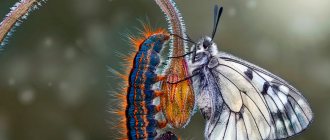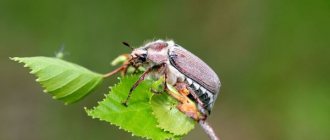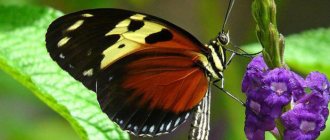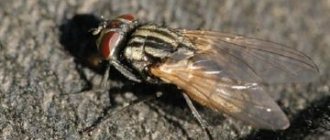With the onset of spring, while digging up beds and plowing the garden, they begin to pay attention to all the strange larvae that can cause harm to seeds, seedlings, roots, and the green part of the plant. One of the most common pests in the garden is the mole cricket, the cockchafer or the beetle. What is the difference between the larvae of the cockchafer and the mole cricket in the photo is demonstrated on different sites. But gardeners continue to invent fables, attributing non-existent features.
Insect larvae
Where can you find mole cricket larvae?
Insects become more active as the weather warms up. They overwinter in the soil at a depth of about 2 m or in compost heaps. As the soil warms up in the spring, they move closer to the surface. The optimal temperature for them is 12 degrees.
The mating season falls in the month of May. At this time, adults and young females emerge from their burrows in the dark and fly in search of a male. After fertilization, the female mole cricket builds a nest at different depths for 2 weeks. In fertile, moist soil, the labyrinth with numerous passages is located at a depth of 5 cm. In sandy soil, it goes 70 cm deep. The average depth of the nest is 15–20 cm.
The female lays about 500 eggs. Such a high number ensures the survival of the insect. In order for the larva to emerge into the light, it is necessary to create favorable conditions - air supply, warmth, and high humidity.
On a note!
The difference between the mole cricket larva and the cockchafer larva is obvious. They cannot be confused. But unknowingly, you can perceive a fat white worm as the baby of any insect. To determine who has wound up, you should pay attention to the place where strange creatures were found and the depth of the nest. Mole cricket larvae love heaps of manure; they destroy plants near the nest in the garden so that light gets into the hole. May beetle larvae always end up in a well-groomed, clean, weeded garden.
Appearance of a mole cricket larva
Experienced gardeners know how to distinguish insect larvae, but beginners have to rack their brains.
There are about 500 eggs in a mole cricket's nest. The length of each of them is from 1 to 3 mm. They have a brown, reddish color. Translucent. Under a microscope you can see a living creature in them. The larva develops in the egg for about 2 weeks. Under favorable conditions, it emerges from the shell earlier.
Initially, these are small, helpless, blind creatures that outwardly resemble a bug, but not a caterpillar. They have a reddish color. Their food is the mother's saliva and egg shells. After approximately 7 days, the first molt occurs. Mole cricket larvae increase in size and more closely resemble an adult insect, which even has wings and can fly.
The full stage of imago formation lasts about 2 years. Under favorable conditions – 1.5 years. At the last stage, the genital organs develop. The mole cricket larva has to go through about 10 molts. Each time the body length increases, more and more reminiscent of an adult beetle.
On a note!
The mole cricket larva looks almost the same as an adult. It does not go through the caterpillar stage, the pupa stage, or turn into a butterfly. The body length of the larvae at the initial stage is about 3 mm, at the end of formation – 5 cm. The size of an adult reaches 12 cm, including the tail and mustache. Photo below.
Mole cricket larvae
May beetle larva
To the question of how beetle larvae differ, you can answer briefly - everyone. From the very first stage of development to the last.
The reproduction process begins in early spring, when the first leaves appear on birch trees. With the onset of persistent warmth - in May, the female cockchafer burrows deep into the soil up to 1 m. There she lays numerous white, transparent eggs.
On a note!
The mole cricket rarely lays eggs at a depth of 1 m. Because the successful development of the offspring requires warmth and air. The female periodically opens the entrances to allow fresh air to enter. At a depth of 1 m, it is problematic to perform such manipulations. When digging a garden to a depth of 50 cm, there is a greater chance of stumbling upon a nest, the offspring of a mole cricket and destroying all unborn pests.
The baby beetles are born after 20 days. In appearance, they are thick, white caterpillars with well-defined rings. Over time, they become larger and rise closer to the surface, feeding on plant roots. It takes several years for the cockchafer larva to develop.
Interesting!
If we compare the larvae of two pests, we can say the following. The offspring of mole crickets cause damage to agricultural crops almost immediately after their birth. Therefore, gardeners use various means of combating them. The young cockchafers are initially harmless and are not so voracious in nature.
As they mature, the baby cockchafers turn into a yellowish, fatty worm, a caterpillar. The head is brown, without eyes, with a well-developed gnawing apparatus. There are 3 pairs of legs in the front part. The body is translucent, food remains are visible in the intestines. There are brown spots on the sides of the rings. These features distinguish the cockchafer from other insects. There is no way to confuse them with baby cabbage mushrooms.
A photo of the larva of the May beetle and the larva of the mole cricket is presented below.
May beetle and mole cricket larvae
Comparative characteristics
To understand the differences between a cockchafer larva and a mole cricket larva, you need to understand the comparative parameters. The former love the roots of vegetable crops and tubers, while the latter prefer nightshade plants.
Attention! Mole cricket larvae can cause no less harm than an adult beetle, since they feed on the roots of plants in the garden.
Similarity
There are practically no similar characteristics. Knowing their description, you can notice a significant difference. Therefore, it is more advisable to study the differences between insects. The only unification is harmfulness.
Differences
The main differences between insects include:
- Mole crickets will damage plants immediately after birth, while cockchafers do this gradually, so the first 2 years are almost harmless.
- Khrushchev prefer warmth more, so they live deeper in the ground, as a result the fight becomes more difficult.
- The May beetle loves the root system and strawberries, and the cabbage beetle loves melons and nightshades.
- The larvae vary in color. Khrushchi are yellowish with pronounced rings on the body, while other insects are brown without rings.
- Maturation is very different; for Khrushchev the entire period takes 5 years, for other pests it takes one to two years.
- The cockchafer is one cm smaller in size.
Main differences
Having become familiar with the appearance of each insect and the features of nest construction, we can highlight the main differences:
- The mole cricket does not go through the worm or pupa stage. It immediately appears in the form of a small insect. It has a brown color, but darkens over time. At the last stage, wings and genitals develop. All this takes about 2 years.
- May beetle larvae are white caterpillars with well-defined rings. They gradually increase in size, reaching a length of 6 cm. They have a twisted ring shape. The head is brown. There are 3 pairs of legs in the front part. This is important to remember, since similar caterpillars are found in the larvae of other beetles that do not harm crops.
On a note!
The difference between the larvae is obvious. One should take into account the fact that the cockchafer develops underground for about 3 years. The cycle continues as the weather warms up. During the first 2 years the larva does not cause much harm, but in the last year it sweeps away everything in its path and turns into a real natural disaster.
In small numbers on a plot of land, the larvae do not cause much harm. This applies to both mole crickets and the May beetle. They loosen the soil and saturate it with useful substances. However, their large numbers can negate all the efforts of the gardener.
What does it look like
The mole cricket is an insect that belongs to the order Orthoptera, the suborder Long-whiskered, and the superfamily Cricketidae. Her body size is quite large. The insect reaches 5-7 cm in length (without mustache and tail).
The cephalothorax accounts for 1/3 of the entire body. The shell covering the chest is strong. There are large eyes and long mustaches (antennae) on the head.
Under the shortened elytra, the developed wings, which are in a folded state, are clearly visible. In front of the body there are limbs equipped with sharp teeth. This is an excellent digging tool, allowing the cabbage plant to dig long tunnels underground.
The insect's body is brown. The abdomen has a light ocher shade, the head and chest are dark brown.
Mole crickets spend most of their time underground, but they fly well, move on top of the ground and even swim. The pest emerges from its dungeon mainly at night.
Prevention
To protect the area from pests, it is necessary to dig up the soil twice a year to a depth of 20 cm or more. In this way you can destroy insect nests and destroy larvae.
When using natural fertilizer - manure, it is better to scatter it around the garden in the fall. Then after winter there will be no viable mole cricket eggs left in it. During the spring fertilization procedure, a person through his own efforts contributes to soil contamination.
As a protective measure, make beds with garlic, throw cloves into a hole with crops, plant flower beds with calendula, marigolds, and chrysanthemums.
You can fight pests with folk remedies or professional ones. In case of severe soil contamination, insecticidal agents (Rembek, Regent, etc.) are used, which remain effective for 1 month and disintegrate completely after 45 days. This is enough to destroy all harmful creatures.
Pest control
Today, gardeners and gardeners have at their disposal a whole arsenal of old folk methods for preventing and combating earthen cancer, as well as a lot of chemicals and devices that allow them to get rid of uninvited guests:
- manure traps;
- beer lures;
- soap and kerosene “baths”;
- aromatherapy;
- “onion shower”;
- installation of wind turbines;
- sound repellers;
- insecticidal preparations.
Fighting insects that survived mammoths and dinosaurs is not so easy. Adherents of organic farming are recommended to use time-tested folk methods, and only as a last resort switch to chemicals.
Mint, bird cherry, chrysanthemums, calendula and garlic are the main natural ingredients with which summer residents fight mole crickets. They plant these plants in different parts of the garden to protect other crops.
But in most cases, chemicals are used to kill arthropods. Deep loosening of the soil is still practiced, but the insect quickly colonizes the beds again and again.
Pests actually enter the plots with manure brought from outside. To prevent the mole cricket from surviving, it is advisable to deliver fertilizer to the beds just before the start of winter. Does not like cabbage and ash, as well as alkaline chemicals.
Since cabbage mushrooms do not “respect” alkali, soap solutions can be poured into the burrows. The pest crawls outside, where it risks being caught by a summer resident.
For a good, effective result, add real (fragrant) sunflower oil to the grains of oats, grains, or other cereals, mix well and add toxic chemicals directly to the grain. Next, you need to distribute it evenly over the area, raking it with a rake.











